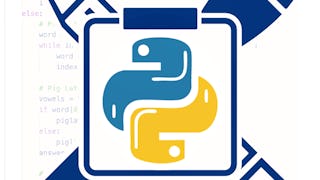- Browse
- Human Computer Interaction
Results for "human computer interaction"
 Status: NewNewStatus: Free TrialFree Trial
Status: NewNewStatus: Free TrialFree TrialSkills you'll gain: Descriptive Statistics, Model Evaluation, Feature Engineering, Probability & Statistics, Supervised Learning, Statistical Hypothesis Testing, Exploratory Data Analysis, Box Plots, Regression Analysis, Statistics, Predictive Modeling, Time Series Analysis and Forecasting, Data Science, Histogram, Data Visualization, Statistical Analysis, Integrated Development Environments, Computer Networking, Python Programming, Server Side
4.7·Rating, 4.7 out of 5 stars15 reviewsBeginner · Specialization · 3 - 6 Months
 G
GGoogle Cloud
Skills you'll gain: Identity and Access Management, SQL, Data Import/Export, Data Integration, Google Cloud Platform, Data Warehousing, Database Design, Data Architecture, Cloud Computing Architecture, Real Time Data
Intermediate · Course · 1 - 3 Months
 Status: Free TrialFree Trial
Status: Free TrialFree TrialSkills you'll gain: Responsible AI, Google Gemini, Anthropic Claude, Human Resources, Artificial Intelligence, Human Resource Strategy, Forecasting, Mitigation
Intermediate · Course · 1 - 4 Weeks
 Status: PreviewPreviewN
Status: PreviewPreviewNNational Taiwan University
Skills you'll gain: Political Sciences, Education and Training, Family Support, Human Learning, Culture, Ethical Standards And Conduct, Sociology, Cultural Diversity, Social Sciences, Ancient History, Human Development, Governance, Interpersonal Communications
Beginner · Course · 1 - 3 Months
 Status: Free TrialFree Trial
Status: Free TrialFree TrialSkills you'll gain: Microservices, Node.JS, API Gateway, Application Deployment, Software Architecture, Cloud Applications, Application Design, Systems Architecture, Web Services, Service Oriented Architecture, Restful API, Communication Strategies
3·Rating, 3 out of 5 stars6 reviewsMixed · Course · 1 - 4 Weeks
 D
DDuke University
Skills you'll gain: Program Development, Debugging, Python Programming, Computer Programming, Computational Logic, Game Design, Interactive Design, Design and Product, Algorithms, Computer Science
Beginner · Course · 1 - 4 Weeks
 Status: Free TrialFree TrialS
Status: Free TrialFree TrialSScrimba
Skills you'll gain: Responsive Web Design, Typography, Cascading Style Sheets (CSS), UI Components, Web Design, Interactive Design, User Interface (UI) Design, HTML and CSS, Browser Compatibility, User Interface (UI), Usability, Interaction Design, Hypertext Markup Language (HTML), Web Content Accessibility Guidelines, Front-End Web Development, Animations, Web Components, Color Theory, Web Development, Web Development Tools
4.3·Rating, 4.3 out of 5 stars9 reviewsIntermediate · Specialization · 1 - 3 Months
 Status: Free TrialFree Trial
Status: Free TrialFree TrialSkills you'll gain: Continuous Delivery, Continuous Deployment, Continuous Integration, Test Driven Development (TDD), Agile Methodology, Test Automation, Unit Testing, Software Development, Software Development Methodologies, Code Review, Debugging, Python Programming, Version Control
3.8·Rating, 3.8 out of 5 stars12 reviewsIntermediate · Course · 1 - 4 Weeks
 Status: PreviewPreviewL
Status: PreviewPreviewLLearnQuest
Skills you'll gain: Docker (Software), Containerization, Microservices, Application Deployment, CI/CD, Data Persistence, DevOps, YAML, Software Development, Virtualization, Application Security, Virtual Networking, Command-Line Interface
3.3·Rating, 3.3 out of 5 stars9 reviewsBeginner · Course · 1 - 4 Weeks
 Status: FreeFree
Status: FreeFreeSkills you'll gain: Docker (Software), CI/CD, Cloud Deployment, Application Deployment, Amazon Elastic Compute Cloud, DevOps, Containerization, Cloud Hosting, Spring Boot, Continuous Deployment, Amazon Web Services, Continuous Integration, GitHub
Intermediate · Guided Project · Less Than 2 Hours
 Status: Free TrialFree Trial
Status: Free TrialFree TrialSkills you'll gain: Web Applications, Computational Logic, Software Development Tools, Business Logic, Other Programming Languages, Program Development, Scalability
4.7·Rating, 4.7 out of 5 stars9 reviewsIntermediate · Specialization · 1 - 3 Months
 Status: Free TrialFree TrialC
Status: Free TrialFree TrialCCoursera
Skills you'll gain: Apache Kafka, Real Time Data, Data Pipelines, Data Processing, Operational Databases, System Monitoring, Scalability, Performance Tuning, Configuration Management
3.5·Rating, 3.5 out of 5 stars11 reviewsBeginner · Course · 1 - 4 Weeks
In summary, here are 10 of our most popular human computer interaction courses
- Python for Data Science: Real Projects & Analytics: EDUCBA
- BigQuery Fundamentals for Snowflake Professionals: Google Cloud
- GenAI for Compensation: Smarter Pay Equity Analysis: Coursera
- 深扣孔孟 (An Inquiry into Confucius and Mencius): National Taiwan University
- Build and Implement Microservices Patterns: NIIT
- Practical Python: Start Your Programming Journey : Duke University
- Improve your CSS: Scrimba
- Integrating Test-Driven Development into Your Workflow: LearnQuest
- Introduction to Docker: LearnQuest
- Build a CI/CD Pipeline with Docker: From Code to Deployment: Coursera










